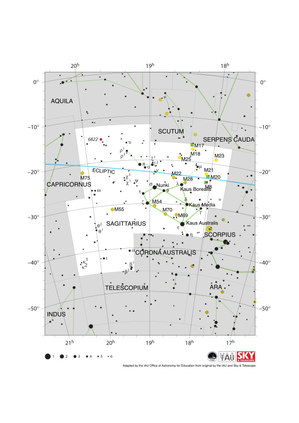Glossary term: Sagittarius A*
Description: Observations of the motions of stars and gas around the center of the Milky Way provide indirect evidence of a supermassive black hole with a mass around 4.5 million times that of the Sun, and approximately 40 million kilometers across, located about 27,000 light years away from Earth. Sagittarius A* (Sagittarius A-star) is the compact radio source that is associated with the supermassive black hole. It has been observed in a range of wavelengths, most notably in radio. The name Sagittarius is because it is located in the constellation of Sagittarius as observed from Earth; the letter A is because it is the brightest and first extrasolar radio source discovered in the constellation; the asterisk is because in physics atoms in excited states are denoted by *, and Sagittarius A* was an exciting discovery.
In 2022, the Event Horizon Telescope Collaboration released the first ever image of the silhouette ("shadow") of the black hole associated with Sagittarius A*.
Related Terms:
See this term in other languages
Term and definition status: This term and its definition have been approved by a research astronomer and a teacher
The OAE Multilingual Glossary is a project of the IAU Office of Astronomy for Education (OAE) in collaboration with the IAU Office of Astronomy Outreach (OAO). The terms and definitions were chosen, written and reviewed by a collective effort from the OAE, the OAE Centers and Nodes, the OAE National Astronomy Education Coordinators (NAECs) and other volunteers. You can find a full list of credits here. All glossary terms and their definitions are released under a Creative Commons CC BY-4.0 license and should be credited to "IAU OAE".
If you notice a factual error in this glossary definition then please get in touch.
Related Diagrams
Sagittarius Constellation Map
Credit: Adapted by the IAU Office of Astronomy for Education from the original by IAU/Sky & Telescope
License: CC-BY-4.0 Creative Commons Attribution 4.0 International (CC BY 4.0) icons









